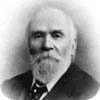
| Isaac Roberts
Isaac Roberts (January 27, 1829-July 17, 1904) was a British astronomer who was a pioneer in photography of nebulae. He was a member of the Liverpool Astronomical Society and was a fellow of the Royal Geological Society. Roberts was also awarded the Gold Medal of the Royal Astronomical Society in 1895.
Life
Roberts was born in Groes, Denbighshire, Wales to William Roberts, a farmer. Although he spent some years of his childhood there, he later moved to Liverpool. There, he became an apprentice to John Johnson & Son (which later became Johnson and Robinson), a firm of mechanical engineers, for 7 years beginning on November 12, 1844. He became a partner in 1847, and supplemented his job with night school. When Peter Robinson died in 1855, Roberts was made manager of the firm. When the other partner, John Johnson died, Roberts was in charge of the contracts and affairs of the firm. Roberts began working as a builder in 1859, and was joined by Peter Robinson's son, J. J. Robinson, in 1862. He was very successful, and became known as one of the best engineers in the region.
Isaac Roberts married his first wife, Ellen Anne, in 1875, making him the son-in-law of Anthony Cartmell. In 1878, Roberts had a 7-inch refractor at his home in Rock Ferry, Birkenhead. Although at the time he used this for visual observation, he began to explore stellar photography, his forte, a few years later.
In 1883, Roberts began experimenting with stellar photography. He first used portrait lenses with apertures varying from to 8 inches. Roberts was pleased with the results, and ordered a 20 inch reflector (silver-on-glass). He took the pictures directly at the focal length, which measured 100 inches, in order to avoid the loss of light that would occur had he used a second mirror. By 1885, Roberts had built an observatory with a 20-inch reflector. This allowed him to make significant progress in the then-developing field of astronomical photography.
By January 1886, Roberts was president of his local astronomical at Liverpool, and had taken 200 pictures of the stars, in addition to pictures of the Orion nebula, the Andromeda nebula and the Pleiades.
Isaac Roberts married Dorothea Klumpke, who was nearly 30 years his junior, in 1901.
Roberts died suddenly in Crowborough, Sussex, England in 1904 (he was 75 years old), widowing his then-wife Dorethea Klumpke. He was cremated soon after his death, and his ashes lay in Crowborough for about five years before he was reburied in Flaybrick Hill Cemetery, in Birkenhead. Roberts was patriotic to his home land of Wales, and continued to use the Welsh language throughout his life. He left a substantial amount of money to Cardiff University, Bangor University, and University of Liverpool. His epitaph read: "In memory of Isaac Roberts, Fellow of the Royal Society, one of England's pioneers in the domain of Celestial Photography. Born at Groes, near Denbigh, January 27, 1829, died at Starfield, Crowboro, Sussex, July 17, 1904, who spent his whole life in the search after Truth, and the endeavour to aid the happiness of others. Heaven is within us. This stone is erected in loving devotion by his widow Dorethea Roberts n�e Klumpke."
Advancements
Some deep space objects were too faint to be viewed by a normal telescope. However, these could be revealed using a photographic plate if the exposure was long enough. However, due to the fact that the Earth rotates, the longer the exposure time was, the blurrier the image would be. On the other hand, if the exposure time was too short, then an image could not be produced due to the faint nature of these deep space objects. Isaac Roberts's solution to this dilemma was to develop a telescope/camera combination that would track the subject, allowing for a long exposure time as well as a clear image.
Some of his notable photographs include photographs of the Orion Nebula and Pleiades. Most consider Roberts's magnum opus to be a photograph showing the spiral structure of the Great Nebula in Andromeda, taken on December 29, 1888. His long exposure of the Andromeda Nebula revealed that it was actually a spiral nebula, which was quite unexpected at the time. Photographs such as this changed astronomy by revealing the true form of nebulae and clusters.
In addition to his considerable advancements in the field of astro-photography, Roberts also invented a machine called the Stellar Pantograver that could engrave stellar positions on copper plates. |
